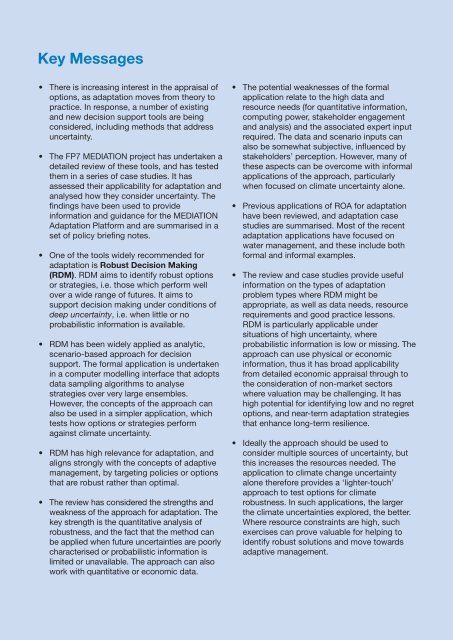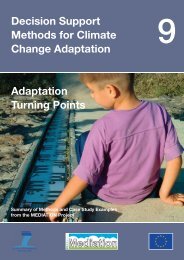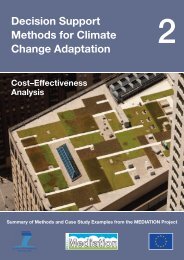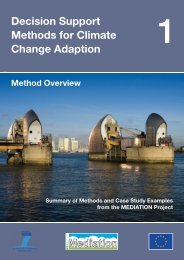Key Messages• There is <strong>in</strong>creas<strong>in</strong>g <strong>in</strong>terest <strong>in</strong> the appraisal ofoptions, as adaptation moves from theory topractice. In response, a number of exist<strong>in</strong>gand new decision support tools are be<strong>in</strong>gconsidered, <strong>in</strong>clud<strong>in</strong>g methods that addressuncerta<strong>in</strong>ty.• The FP7 MEDIATION project has undertaken adetailed review of these tools, and has testedthem <strong>in</strong> a series of case studies. It hasassessed their applicability for adaptation andanalysed how they consider uncerta<strong>in</strong>ty. Thef<strong>in</strong>d<strong>in</strong>gs have been used to provide<strong>in</strong>formation and guidance for the MEDIATIONAdaptation Platform and are summarised <strong>in</strong> aset of policy brief<strong>in</strong>g notes.• One of the tools widely recommended foradaptation is Robust Decision Mak<strong>in</strong>g(RDM). RDM aims to identify robust optionsor strategies, i.e. those which perform wellover a wide range of futures. It aims tosupport decision mak<strong>in</strong>g under conditions ofdeep uncerta<strong>in</strong>ty, i.e. when little or noprobabilistic <strong>in</strong>formation is available.• RDM has been widely applied as analytic,scenario-based approach for decisionsupport. The formal application is undertaken<strong>in</strong> a computer modell<strong>in</strong>g <strong>in</strong>terface that adoptsdata sampl<strong>in</strong>g algorithms to analysestrategies over very large ensembles.However, the concepts of the approach canalso be used <strong>in</strong> a simpler application, whichtests how options or strategies performaga<strong>in</strong>st climate uncerta<strong>in</strong>ty.• RDM has high relevance for adaptation, andaligns strongly with the concepts of adaptivemanagement, by target<strong>in</strong>g policies or optionsthat are robust rather than optimal.• The review has considered the strengths andweakness of the approach for adaptation. Thekey strength is the quantitative analysis ofrobustness, and the fact that the method canbe applied when future uncerta<strong>in</strong>ties are poorlycharacterised or probabilistic <strong>in</strong>formation islimited or unavailable. The approach can alsowork with quantitative or economic data.• The potential weaknesses of the formalapplication relate to the high data andresource needs (for quantitative <strong>in</strong>formation,comput<strong>in</strong>g power, stakeholder engagementand analysis) and the associated expert <strong>in</strong>putrequired. The data and scenario <strong>in</strong>puts canalso be somewhat subjective, <strong>in</strong>fluenced bystakeholders’ perception. However, many ofthese aspects can be overcome with <strong>in</strong>formalapplications of the approach, particularlywhen focused on climate uncerta<strong>in</strong>ty alone.• Previous applications of ROA for adaptationhave been reviewed, and adaptation casestudies are summarised. Most of the recentadaptation applications have focused onwater management, and these <strong>in</strong>clude bothformal and <strong>in</strong>formal examples.• The review and case studies provide useful<strong>in</strong>formation on the types of adaptationproblem types where RDM might beappropriate, as well as data needs, resourcerequirements and good practice lessons.RDM is particularly applicable undersituations of high uncerta<strong>in</strong>ty, whereprobabilistic <strong>in</strong>formation is low or miss<strong>in</strong>g. Theapproach can use physical or economic<strong>in</strong>formation, thus it has broad applicabilityfrom detailed economic appraisal through tothe consideration of non-market sectorswhere valuation may be ch<strong>all</strong>eng<strong>in</strong>g. It hashigh potential for identify<strong>in</strong>g low and no regretoptions, and near-term adaptation strategiesthat enhance long-term resilience.• Ide<strong>all</strong>y the approach should be used toconsider multiple sources of uncerta<strong>in</strong>ty, butthis <strong>in</strong>creases the resources needed. Theapplication to climate change uncerta<strong>in</strong>tyalone therefore provides a ‘lighter-touch’approach to test options for climaterobustness. In such applications, the largerthe climate uncerta<strong>in</strong>ties explored, the better.Where resource constra<strong>in</strong>ts are high, suchexercises can prove valuable for help<strong>in</strong>g toidentify robust solutions and move towardsadaptive management.
Robust Decision Mak<strong>in</strong>gIntroductionThere is <strong>in</strong>creas<strong>in</strong>g policy <strong>in</strong>terest <strong>in</strong> the appraisalof options, as adaptation moves from theory topractice. At the same time, it is recognised thatthe appraisal of climate change adaptation<strong>in</strong>volves a number of major ch<strong>all</strong>enges,particularly the consideration of uncerta<strong>in</strong>ty. Inresponse, a number of exist<strong>in</strong>g and new decisionsupport tools are be<strong>in</strong>g considered for adaptation.The European Commission FP7 fundedMEDIATION project (Methodology for EffectiveDecision-mak<strong>in</strong>g on Impacts and AdaptaTION) islook<strong>in</strong>g at adaptation decision support tools, <strong>in</strong>l<strong>in</strong>e with its objectives to advance the analysis ofimpacts, vulnerability and adaptation, and topromote knowledge shar<strong>in</strong>g through aMEDIATION Adaptation Platform (http://www.mediation-project.eu/platform/). To complementthe <strong>in</strong>formation on the Platform, a series of <strong>Policy</strong><strong>Brief<strong>in</strong>g</strong> <strong>Notes</strong> have been produced on DecisionSupport Methods for Climate Change Adaptation.An overview of <strong>all</strong> the decision support toolsreviewed is provided <strong>in</strong> <strong>Policy</strong> <strong>Brief<strong>in</strong>g</strong> Note 1:Method Overview, which summarises eachmethod, discusses the potential relevance foradaptation and provides guidance on theirpotential applicability. The methods considered<strong>in</strong>clude exist<strong>in</strong>g appraisal tools (cost-benefitanalysis, cost-effectiveness analysis and multicriteriaanalysis), as well as techniques that morefully address uncerta<strong>in</strong>ty (real options analysis,robust decision mak<strong>in</strong>g, portfolio analysis anditerative risk (adaptive) management). It also<strong>in</strong>cludes complementary tools that can assist <strong>in</strong>adaptation assessment, <strong>in</strong>clud<strong>in</strong>g analyticalhierarchic processes, social network analysisand adaptation turn<strong>in</strong>g po<strong>in</strong>ts. Additional<strong>in</strong>formation on each method is presented <strong>in</strong> aseparate <strong>Policy</strong> <strong>Brief<strong>in</strong>g</strong> <strong>Notes</strong> (2 – 10).This <strong>Policy</strong> Brief (Note 3) provides a summary ofrobust decision mak<strong>in</strong>g. It provides a briefsynthesis of the approach, its strengths andweaknesses, the relevance for adaptation, how itconsiders uncerta<strong>in</strong>ty, and presents case studyexamples. It is stressed that this note onlyprovides an overview: more detailed <strong>in</strong>formationis available <strong>in</strong> MEDIATION deliverables, andsources and l<strong>in</strong>ks on the MEDIATION AdaptationPlatform.Description of the MethodRobust Decision Mak<strong>in</strong>g (RDM) is a decisionsupport tool that can be used <strong>in</strong> situations ofdeep uncerta<strong>in</strong>ty. RDM is premised on theconcept of “robustness” rather than “optimality”.The approach was developed to helppolicymakers make more <strong>in</strong>formed near-termdecisions which have long-term consequences.RDM <strong>in</strong>volves test<strong>in</strong>g near-term strategiesacross a large number of plausible future states.The primary aim is to help policymakersanticipate or mitigate the negative impacts ofpossible future surprises result<strong>in</strong>g from the<strong>in</strong>teraction of factors (exogenous uncerta<strong>in</strong>ties)outside of their control, with measures that arewith<strong>in</strong> their control. This is described as decisionmak<strong>in</strong>g under situations of deep uncerta<strong>in</strong>ty, i.e.when little or no probabilistic <strong>in</strong>formation isavailable.The approach can be applied when traditionalrisk <strong>in</strong>formation (e.g. well-def<strong>in</strong>ed probabilitydistributions) is not available, when there is noagreement on the conceptual models to use, orhow to evaluate the desirability of alternativeoutcomes. RDM aims to help decision makers totake robust or resilient decisions today, despiteimperfect and uncerta<strong>in</strong> <strong>in</strong>formation about thefuture.RDM has developed as an analytic, scenariobasedapproach for strategic decision-mak<strong>in</strong>g.The formal application of the approach <strong>in</strong>volvesthe comb<strong>in</strong>ation of both qualitative andquantitative <strong>in</strong>formation through a human andcomputer-guided modell<strong>in</strong>g <strong>in</strong>terface (Lempert etal, 2003: Groves and Lempert, 2007). Thispowerful comb<strong>in</strong>ation surpasses the analyticalpower of traditional qualitative and quantitativedecision support tools. This computer basedanalysis <strong>all</strong>ows RDM to evaluate how differentstrategies perform under large ensembles, oftenof thousands or millions of runs, which reflectdifferent plausible future conditions (Lempert etal, 2003). Iterative and <strong>in</strong>teractive techniques arethen applied to “stress test” different strategies,identify<strong>in</strong>g potential vulnerabilities orweaknesses of proposed approaches (Dessai etal., 2009). The formal application of the approachis characterised by the use of data m<strong>in</strong><strong>in</strong>galgorithms which carry out vulnerability-and-1





